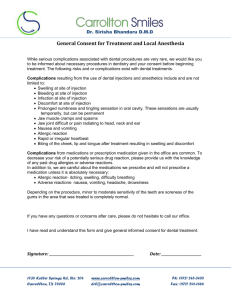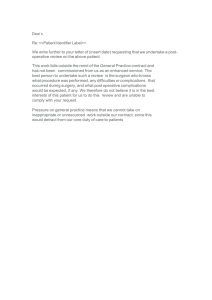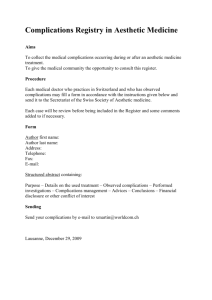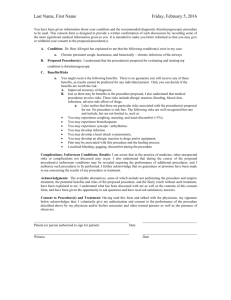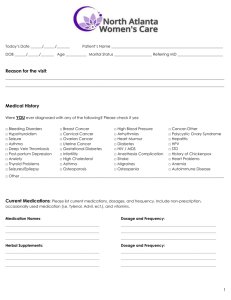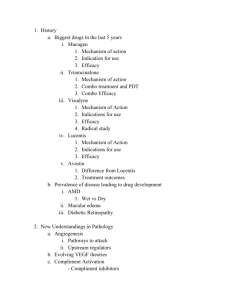NOTE TO PHYSICIANS:
advertisement
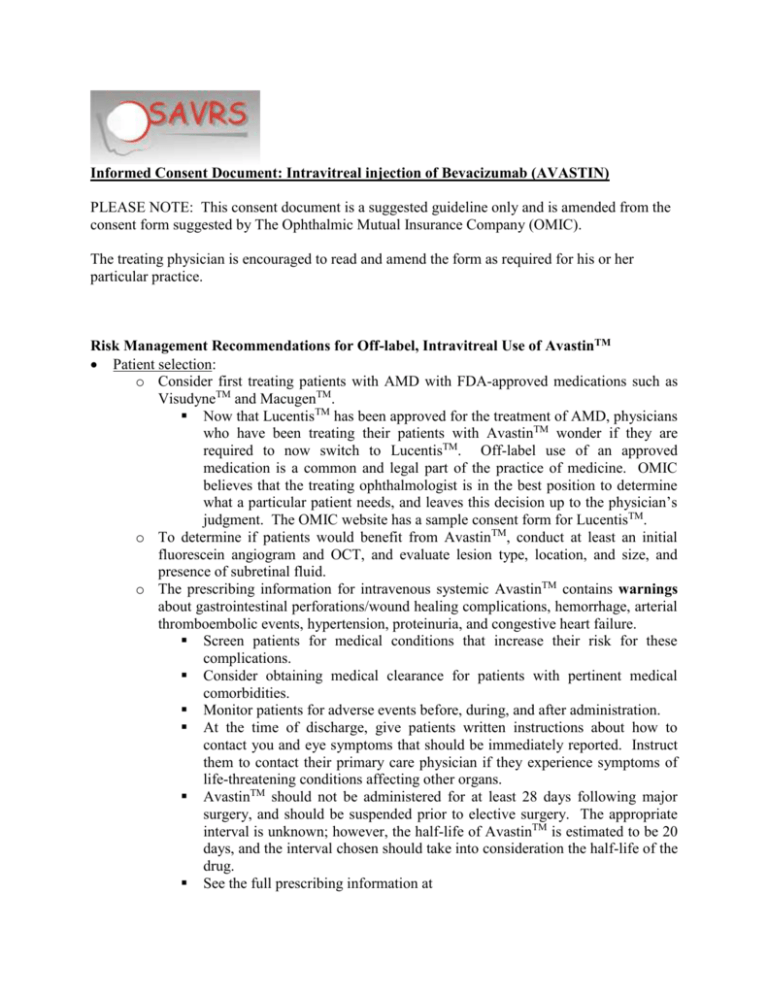
Informed Consent Document: Intravitreal injection of Bevacizumab (AVASTIN) PLEASE NOTE: This consent document is a suggested guideline only and is amended from the consent form suggested by The Ophthalmic Mutual Insurance Company (OMIC). The treating physician is encouraged to read and amend the form as required for his or her particular practice. Risk Management Recommendations for Off-label, Intravitreal Use of AvastinTM Patient selection: o Consider first treating patients with AMD with FDA-approved medications such as VisudyneTM and MacugenTM. Now that LucentisTM has been approved for the treatment of AMD, physicians who have been treating their patients with AvastinTM wonder if they are required to now switch to LucentisTM. Off-label use of an approved medication is a common and legal part of the practice of medicine. OMIC believes that the treating ophthalmologist is in the best position to determine what a particular patient needs, and leaves this decision up to the physician’s judgment. The OMIC website has a sample consent form for LucentisTM. o To determine if patients would benefit from AvastinTM, conduct at least an initial fluorescein angiogram and OCT, and evaluate lesion type, location, and size, and presence of subretinal fluid. o The prescribing information for intravenous systemic AvastinTM contains warnings about gastrointestinal perforations/wound healing complications, hemorrhage, arterial thromboembolic events, hypertension, proteinuria, and congestive heart failure. Screen patients for medical conditions that increase their risk for these complications. Consider obtaining medical clearance for patients with pertinent medical comorbidities. Monitor patients for adverse events before, during, and after administration. At the time of discharge, give patients written instructions about how to contact you and eye symptoms that should be immediately reported. Instruct them to contact their primary care physician if they experience symptoms of life-threatening conditions affecting other organs. AvastinTM should not be administered for at least 28 days following major surgery, and should be suspended prior to elective surgery. The appropriate interval is unknown; however, the half-life of AvastinTM is estimated to be 20 days, and the interval chosen should take into consideration the half-life of the drug. See the full prescribing information at http://www.avastin.com/avastin/prescribingPIPro.m Preparation of the medication o Proper aseptic technique should be utilized during the preparation and administration of the injection. o The medication comes in preservative-free vials intended for use at a much higher concentration on a single cancer patient. To ensure safe administration, it is strongly advised that compounding be performed under sterile conditions and that the recommended safe storage precautions are respected. Preventing and managing complications from intravitreal injection o Intravitreal injections have caused endophthalmitis, retinal detachment, and increased intraocular pressure. Be familiar with the latest guidelines on care before, during, and after administration. One such source is the article by Flynn, Harry W. and Scott, Ingrid U., Evolving Guidelines For Intravitreous Injections. Retina 24: S3-S19, 2004. o Educate the patient about the warning signs of complications and how to contact you. Consider giving these instructions in writing. Informed consent discussion and documentation o Warnings and complications associated with intravenous systemic use in patients with colorectal cancer (see above) Patients should be warned of these potential complications, but told that patients who experienced them had metastatic colon and lung cancer, and were given 400 times the dose at more frequent intervals in a way that spread the drug throughout their bodies. While the significantly lower dose and intravitreal administration is believed to reduce the risk of these complications, there is no FDA-approved study proving this reduced risk. Patients should also be told that whenever a medication is used in a large number of patients, a small number of coincidental life-threatening problems may occur that have no relationship to the treatment. Several studies of AvastinTM for ocular conditions have been published. The study of ophthalmic use of IV AvastinTM excluded patients with a history of myocardial infarction, stroke, or uncontrolled hypertension, and reported that patients developed only a mild elevation in blood pressure. See Michels S, Rosenfeld JR et al. Systemic Bevacizumab (Avastin) Therapy for Neovascular Age-Related Macular Degeneration: Twelve-Week Results of an Uncontrolled Open-Label Clinical Study. Ophthalmology 2005;112:10351047. Patients treated with intravitreal AvastinTM for AMD and macular edema did not have these elevations. See Rosenfeld, PJ, Moshfeghi AA, Puliafito CA. Optical Coherence Tomography Findings After an Intravitreal Injection of Bevacizumab (Avastin) for Neovascular Age-Related Macular Degeneration. Ophthalmic Surg Lasers Imaging 2005; 36:331-335, and Rosenfeld, PJ, Fung AE, Puliafito CA. Optical Coherence Tomography Findings After Intravitreal Injection of Bevacizumab (Avastin) for Macular Edema From Central Retinal Vein Occlusion. Ophthalmic Surg Lasers Imaging 2005; 36:336-339. o “Off-label” status. Intravitreal AvastinTM for AMD, conditions with similar manifestations, and refractory macular edema is not an approved use, so patients should be 2 informed of its “off-label” status. Now that the related Genentech medication LucentisTM has been approved, inform patients that a very similar medication has been approved for this condition and route. o Consent for ongoing treatment In general, informed consent may be considered to have ongoing force and effect until 1) the patient revokes the consent or 2) circumstances (i.e., the patient’s medical or ocular condition) change so as to materially affect the nature of the procedure or the risk/benefit ratio. Prior to subsequent injections, the continued need, effectiveness, and safety of the medication should be evaluated and documented. If the patient’s medical or ocular condition changes to the point that the risk/benefit ratio is affected, it would be prudent to either discontinue treatment or obtain and document informed consent again. o Documentation Document the decision-making process that led to choosing AvastinTM as the treatment for the patient. Note results of earlier attempts at treatment and the results of diagnostic tests. . 3 AVASTIN TM INFORMED CONSENT FOR (BEVACIZUMAB) INTRAVITREAL INJECTION INDICATIONS Age-related macular degeneration (AMD) is the leading cause of blindness in people over 50 years of age. There are two types of macular degeneration: dry and wet. In the “wet” form of AMD, abnormal blood vessels grow in the back of the eye. Sometimes these vessels leak blood or fluid that causes blurred or distorted vision. Without treatment, vision loss may be quick and severe. There are other eye conditions that cause loss of vision due to abnormal growth of blood vessels in the back of the eye. These can occur even in young patients, and include, but are not limited to, conditions such as high myopia (nearsightedness), histoplasmosis, angioid streaks, and eye injury. Sometimes there is no known reason for the abnormal blood vessels. Without treatment, vision loss may be quick and severe. Refractory macular edema, or swelling around the macula, is edema that affects vision but does not respond adequately to the usual treatment methods. It can occur with conditions such as central retinal vein occlusion and diabetic retinopathy. Without effective treatment, vision loss could progress and become permanent. POSSIBLE BENEFITS AND “OFF-LABEL” STATUS AvastinTM was not initially developed to treat your eye condition. Based upon the results of clinical trials that demonstrated its safety and effectiveness, AvastinTM was approved by the Food and Drug Administration (FDA) for the treatment of metastatic colorectal cancer. As a condition of approval, the manufacturer produced a “label” explaining the indications, risks, and benefits. The label explains that AvastinTM works by blocking a substance known as vascular endothelial growth factor or VEGF. Blocking or inhibiting VEGF helps prevent further growth of the blood vessels that the cancer needs to continue growing. 4 Once a device or medication is approved by the FDA, physicians may use it “off-label” for other purposes if they are well-informed about the product, base its use on firm scientific method and sound medical evidence, and maintain records of its use and effects. Ophthalmologists are using AvastinTM “off-label” to treat AMD and similar conditions since research indicates that VEGF is one of the causes for the growth of the abnormal vessels that cause these conditions. Some patients treated with AvastinTM had less fluid and more normal-appearing maculas, and their vision improved. AvastinTM is also used, therefore, to treat macular edema, or swelling of the macula. Recently, a medication similar in function and designed for intravitreal administration was approved by the FDA for the treatment of AMD. POSSIBLE LIMITATIONS AND ADMINISTRATION The goal of treatment is to prevent further loss of vision. Although some patients have regained vision, the medication may not restore vision that has already been lost, and may not ultimately prevent further loss of vision caused by the disease. After the pupil is dilated and the eye is numbed with anesthesia, the medication is injected into the vitreous, or jelly-like substance in the back chamber of the eye. AvastinTM is administered by an injection into your eye as needed at regular intervals (about every four to six weeks); your ophthalmologist will tell you how often you will receive the injection, and for how long. ALTERNATIVES You do not have to receive treatment for your condition, although without treatment, these diseases can lead to further vision loss and blindness, sometimes very quickly. Other forms of treatment are available. At present, there are three FDA-approved treatments for neovascular age-related macular degeneration. The first two are photodynamic therapy with a drug called VisudyneTM and injection into the eye of a drug called MacugenTM. Although both of these treatments have been proven to slow down the rate of visual loss, most people do not get back better vision. The third medication, LucentisTM is similar to AvastinTM. Your doctor will discuss with you the benefits and risks 5 associated with these other choices of treatment. In addition to the FDA-approved medications, some ophthalmologists use intravitreal KenalogTM—a long-acting cortisone-like drug—“off-label” to treat eye conditions like yours. COMPLICATIONS FROM THE MEDICATION AND INJECTION Complications when AvastinTM is given to patients with cancer When AvastinTM is given to patients with metastatic colorectal cancer, some patients experienced serious and sometimes life-threatening complications, such as gastrointestinal perforations or wound healing complications, hemorrhage, arterial thromboembolic events (such as stroke or heart attack), hypertension, proteinuria, and congestive heart failure. Patients who experienced these complications not only had metastatic colon cancer, but were also given 400 times the dose you will be given, at more frequent intervals, and in a way (through an intravenous infusion) that spread the drug throughout their bodies. Risk when AvastinTM is given to treat patients with eye conditions Ophthalmologists believe that the risk of these complications for patients with eye conditions is low. Patients receiving AvastinTM for eye conditions are healthier than the cancer patients, and receive a significantly small dose, delivered only to the cavity of their eye. While there are no FDA-approved studies about the use of AvastinTM in the eye that prove it is safe and effective, LucentisTM, a similar drug, was recently approved for AMD. One study of patients who received AvastinTM through an intravenous infusion reported only a mild elevation in blood pressure. Another study of patients treated like you will be with intravitreal AvastinTM (that is, AvastinTM injected into the eye) did not have these elevations or the other serious problems seen in the patients with cancer. 6 However, the benefits and risks of intravitreal AvastinTM for eye conditions are not yet fully known. In addition, whenever a medication is used in a large number of patients, a small number of coincidental life-threatening problems may occur that have no relationship to the treatment. For example, patients with diabetes are already at increased risk for heart attacks and strokes. If one of these patients being treated with AvastinTM suffers a heart attack or stroke, it may be caused by the diabetes and not the AvastinTM treatment. Known risks of intravitreal eye injections Your condition may not get better or may become worse. Any or all of these complications may cause decreased vision and/or have a possibility of causing blindness. Additional procedures may be needed to treat these complications. During the follow up visits or phone calls, you will be checked for possible side effects and the results will be discussed with you. Possible complications and side effects of the procedure and administration of AvastinTM include but are not limited to retinal detachment, cataract formation (clouding of the lens of the eye), glaucoma (increased pressure in the eye), hypotony (reduced pressure in the eye), damage to the retina or cornea (structures of the eye), and bleeding. There is also the possibility of an eye infection (endophthalmitis). You may receive eye drops with instructions on when to use them to reduce the possibility of this occurring. Any of these rare complications may lead to severe, permanent loss of vision. Patients receiving an injection of AvastinTM may experience less severe side effects related to the pre-injection preparation procedure (eyelid speculum, anesthetic drops, dilating drops, antibiotic drops, povidoneiodine drops and the injection of the anesthetic). These side effects may include eye pain, subconjunctival hemorrhage (bloodshot eye), vitreous floaters, irregularity or swelling of the cornea, inflammation of the eye, and visual disturbances. 7 PATIENT RESPONSIBILITIES 1. I will immediately contact my ophthalmologist if any of the following signs of infection or other complications develop: pain, blurry or decreased vision, sensitivity to light, redness of the eye (compared to immediately after the injection), or discharge from the eye. I have been instructed NOT to rub my eyes or swim for three days after each injection. I will keep all post-injection appointments or scheduled telephone calls so my doctor can check for complications. 2. Although the likelihood of serious complications affecting other organs of my body is low, I will immediately contact my primary care physician or go to the Emergency Room if I experience abdominal pain associated with constipation and vomiting, abnormal bleeding, chest pain, severe headache, slurred speech, or weakness on one side of the body. As soon as possible, I will also notify my ophthalmologist of these problems. 3. I will inform my ophthalmologist if I need to have any surgery, and I will inform any other surgeon, including dentists, that I am on a medication that needs to be stopped before I can have surgery. ____________________________ Patient’s Signature ___________________ Date ____________________________ Witness’s Signature ___________________ Date 8 PATIENT CONSENT The above explanation has been read by/to me. The nature of my eye condition has been explained to me and the proposed treatment has been described. The risks, benefits, alternatives, and limitations of the treatment have been discussed with me. All my questions have been answered. I understand that AvastinTM was approved by the FDA for the treatment of metastatic colorectal cancer, and has not been approved for the treatment of eye conditions. Nevertheless, I wish to be treated with AvastinTM, and I am willing to accept the potential risks that my physician has discussed with me. I hereby authorize Dr. __________________ to administer the intravitreal injection of AvastinTM in my _______ (state “right” or “left”) eye at regular intervals as needed. This consent will be valid until I revoke it or my condition changes to the point that the risks and benefits of this medication for me are significantly different. I understand that AvastinTM is used in an off-label capacity for use in the eye. This status may result in my medical aid refusing funding for the its use in which case I will be responsible for the costs of treatment. ____________________________ Patient’s Signature ___________________ Date ____________________________ Witness’s Signature ___________________ Date Version 8/2/06 9

